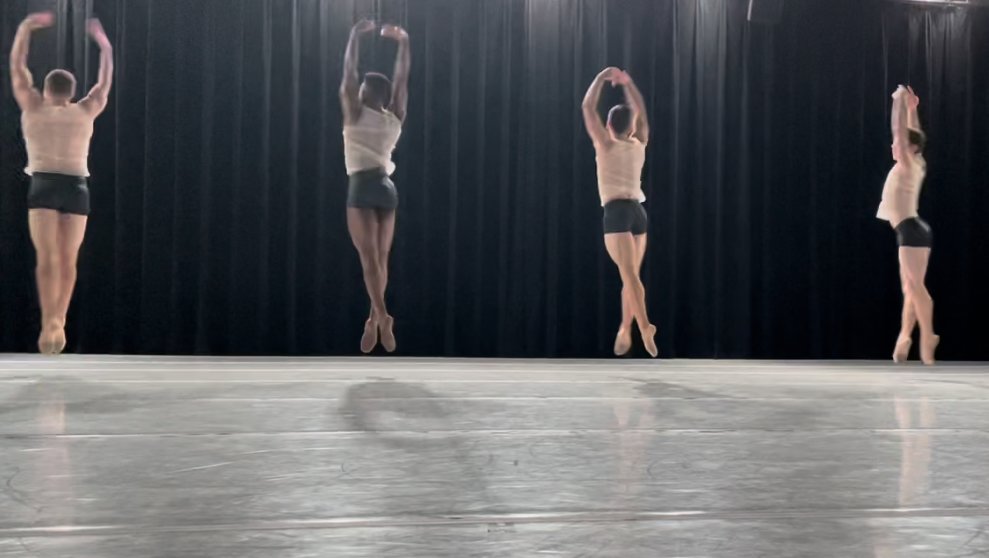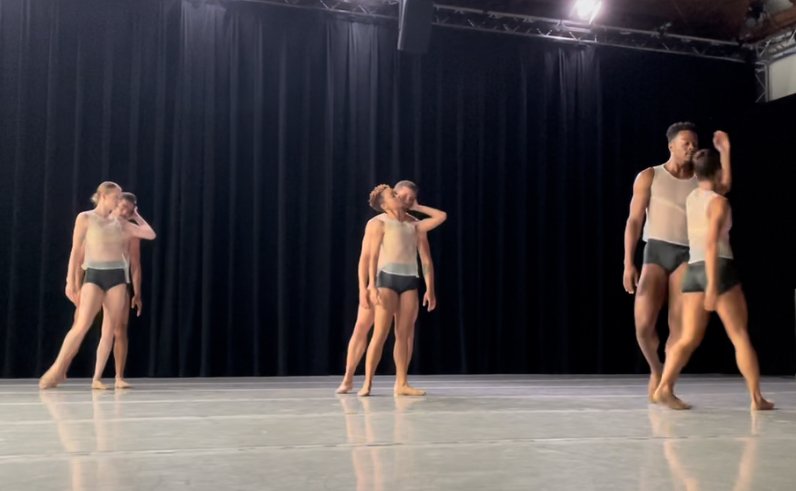text by Avery Wheless
photographs by Skye Varga
We are living through a time when the worst human suffering imaginable is both televised and ignored, when disorientation is used as a tool of control. In direct response to this intractable cognitive dissonance, Simulacra, choreographed by Megan Paradowski, insists on the urgency of embodied memory. Paradowski’s 30-minute choreographed piece premiered September 11 at LA Dance Project’s LAUNCH, featuring dancers Jessy Crist, Maddie Lacambra, Travis Lim, Nadia Maryam, Jonah Tran, and Marco Vega. Paradowski’s choreography unfolded alongside a 40-pound ice sculpture by Heidi Ross, with a soundscape by Ian Wellman, costumes by Gabrielle Kraus, and lighting by Caleb Wildman—each element contributing to a fully immersive environment. What emerged was a work both haunting and hopeful, one that situates itself within a global landscape of suppressed truths and performative power.
Referencing Alexei Yurchak’s Everything Was Forever, Until It Was No More—a study of the Soviet Union’s descent into “hypernormalisation,” where repetition transformed falsehoods into reality—Simulacra responds to the collapse we are currently living through: the wars in Ukraine and Gaza, mass deportations, the digital fog of misinformation, and the slow, aestheticized demise of the climate.
The stage was intentionally configured in the middle of the audience, dissolving any hierarchy of perspective and forcing viewers to confront the work from every angle. Ross’s monumental ice sculpture, carved from frozen beet juice, stood at the center, steadily bleeding onto the stage, staining the floor, and eventually the dancers’ garments. The sculpture became both a visual anchor and sonic participant, as Wellman incorporated the crackling and fracturing of the ice into the score. Its gradual dissolution mirrored the choreography’s central theme: that violence leaves a stain. The red liquid’s gradual seeping into fabric and skin became a quiet insistence that history persists in the body.
Paradowski transforms the performance space into a site of collective witnessing. Her choreography doesn’t merely present movement—it reveals what we might otherwise refuse to see. The dancers’ bodies are both medium and message, extending and releasing with a tension that exists even in levity. Watching them push and pull, fall and catch, resist and support—this continual ebb and flow—called to mind the properties of water: its ability to buoy, to drown, to hold, and to erode. Grief, care, and survival are traced in gestures that feel both urgent and inevitable.
Having worked with Paradowski in the studio over the past few months, I’ve seen how she uses choreography as a tool for inquiry—how movement can reshape ideas and give form to what is otherwise unspoken. Simulacra is the fullest articulation of that philosophy. Her performance positions the body as both vessel and witness, capable of absorbing violence and preserving truth long after the events have passed.
Because she sees the world through movement, each phrase of choreography is like trying on a garment. In rehearsal, I might move a certain way and she’ll say, “Yes—that looks good on your body.” I thought about that often while witnessing Simulacra evolve—how certain gestures don’t strive for beauty, but for truth. Some are erratic, others jarring or uncomfortable, but each one fits. Each one says exactly what it must.
The more I’ve come to know Megan—both as a choreographer and as a person—the more I’ve come to deeply admire this work. Simulacra holds space for a world that feels as though it is unraveling, and in its insistence on movement, it seems to hold the threads together. As Pina Bausch once said, “I’m not so interested in how they move as in what moves them.” Megan’s work embodies that sentiment completely.
Dance has always felt like one of the most powerful tools we have for understanding the world—its violence, its tenderness, its chaos, its grace. Simulacra ends not with resolution, but with an image: of time slipping, collapsing, staining everything it touches. It reminds us that the world is changing faster than we can process—but that memory, like pigment in water, lingers.
Even in the aftermath of destruction, there is room for collective care. Amid dissolution, there is still buoyancy—a possibility for reforming, softening, and holding. Because the body—bearing trauma, rhythm, and breath—may be the last site of reality. And because in times like these, consciousness itself becomes an act of rebellion. We must move to keep ourselves whole.


